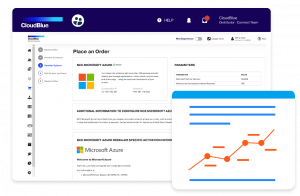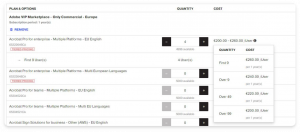There’s money in the cloud.
That fact is driving a wave of economic and operational change affecting businesses large and small: by providing goods and services over the Internet, by using recurring revenue and subscription-based models, by utilizing available company data to maximize the opportunities in front of them, businesses in e-commerce & retail, healthcare, travel, food services, manufacturing, entertainment, tech & software distribution, channel applications and more are realizing revenue growth and additional opportunities by applying digital transformation and cloud monetization strategies.
As business of all kinds launch, scale, and monetize their cloud and digital services, estimates that the monetization market will surpass $11 billion in the next few years seem almost restrained.

Digital marketplaces allow vendors to bundle products and up-sell customers, such as exampled in commonly-purchased computer and software bundles.
In our digitally-mediated world, buyers and sellers of all stripes look for a B2C or B2B marketplace with a convenient and familiar one-stop-shop experience, be it major online retailers like Amazon or Temu; emerging food service companies like Blue Apron, DoorDash or LoveGoodFats; big tech giants such as Adobe, Microsoft or VMWare. They’ve all found money in the cloud.
Digital marketplaces are advantaged by the fact that the operator controls the customer experience, creating a familiar relationship that can lead to recurring revenue, can be trusted to up-sell customers with bundled products and services from other companies, and can utilize third-party marketplaces to sell their own goods.
But while many business owners understand the opportunities found in digitizing their sales and services, the suite of necessary skills, experiences, and technologies may mean they turn to a cloud platform provider. There’s good advice and assistance to be found when developing a digital marketplace that brings a recurring revenue stream, broader product catalogue, and more resilient supply chain.

An online monetization platform is a critical part of the strategy in support of a company’s digital transformation.
The first step of the process is securing a monetization platform. It’s a critical part of the strategy because it’s going to support digital transformation, participation in the subscription economy, and the future of the company, says CloudBlue President Uddhav Gupta.
CloudBlue is an Ingram Micro business that helps service providers of all kinds monetize their cloud and digital services. Cloud platform providers, also sometimes called marketplace operation applications (MOAs), support any number of businesses as they develop their digital ecosystems. The need for platform support continues to grow as more companies turn to a wider cloud-based offering of products, services, and digital goods.
But Gupta, based on nearly two decades of platform-building experience in digital commerce, the subscription economy, and monetization platforms, knows there are good and bad places to start the digital transformation journey:
“A lot of people basically think about digital transformation is about rebuilding your brand, right? Making your brand look more sexy, more cool,” he observes with a smile. “That’s not what digital transformation is.
“Digital transformation really is how you accelerate your revenue. So, I think digital transformation needs to happen at every company, at every level. [I]t’s not because of a FOMO effect of like, you know, fear of missing out. I think it’s the R, right? Revenue!”
CloudBlue has charted the monetization strategy for multiple clients around the world, both large and small, helping them with sophisticated cataloguing systems, billing engines, integration platforms, and the ability to overlay commerce or experience workflows on top of traditional systems.

CloudBlue President Uddhav Gupta
Gupta brought a similar track record to Cloud Blue: When he with SAP, he spearheaded the transformation of their platform business into a multi-cloud platform-as-a-service, offering enterprise and developer-friendly subscription models. While with Pure Storage, he created new Storage-, AI Ops-, and Disaster Recovery-as-a-Service offerings.
Gupta describes a key component of the digital transformation needed even before the technical processes come into play: an assessment and planning phase.
“This is where you want to understand what you want to do,” he explains. “You’re doing the transformation to achieve modernization of your infrastructure or you’re doing this to derive operational efficiencies by taking more digital routes to market or you basically making the experience and things easier for your customer.”
The key asks: how are those efforts going to pay dividends (and in what time frame)?
With a clear company mission and solid strategic thinking behind the answers, Gupta outlines a second phase as implementation and integration, which often comes with an identified need for modernizing the infrastructure, moving processes to the cloud, basically using more external computing capabilities and expertise.
An on-going assessment and benchmarking of the new revenue objectives, and the infrastructure supporting them, makes the digital transformation an on-going process, rather than a one-off event. Data analysis is a crucial component of the assessment.
Once validated through data, the transformation and monetization strategy would continue with a phase dedicated to optimizing growth and achieving scale, to always making things better.
“I think a big, big, big piece of the digital transformation is leveraging data to make decisions,” he underscores by way of examples: “What information can you get from your customers? What feedback can you get from your operations team? What feedback can you get from your go-to-market team?”
Looking at the data and making smart decisions – fast decisions – is a step in digital transformation and Gupta says companies need to invest in very good data collection, harnessing, and insight systems or support.
“This is how you can basically look at opportunities that you missed and you can basically drive business growth. Analyze user data, customer behaviour, market trends and make data-driven decisions to maximize revenue potential. That’s what monetization platforms like Cloud Blue support.”
From his experienced perspective, Uddhav Gupta believes that the future of consuming almost any product can be a service offering in the new subscription economy. Digital transformation and cloud monetization presents many opportunities for revenue growth.
As Gupta sees it, finding money in the cloud is the biggest – and best – transformation a business can have.

-30-



